A Key Performance Indicator (KPI) is a selected measurement that businesses track to demonstrate how effective they are in achieving their targeted goals.
Go into any performance review or executive meeting. KPIs will come up.
In other words, a KPI is not the actual objective. KPIs help to measure if you’re on track to meet a goal.
Leveraging the most relevant data into your KPIs can pay off in a huge way. One study found if the median Fortune 1000 business increased the usability of its data by 10%, it would translate to an increase in $2.01 billion in total revenue every year. Yes, each year.
Your high-level goal might be to increase revenue 20% within the next year. So you may monitor KPIs that help support increased revenue including:
- Return on ad spend
- Number of appointments booked
- Sales by region
If you’re looking to use KPIs to make a major business impact, read on to find out:
Table of Contents
How Do KPIs Improve Your Business?
First and foremost, KPIs help you evaluate whether you’re achieving specific measurable milestones on the way to your high-level goal. Once they’re clearly defined and tracked, KPIs give companies:
- A way to track progress on business goals
- Ability to see how successful they are at reaching monthly, quarterly, and annual targets
- Power to make more informed decisions
- Objective results for evaluating performance; with past performance data you can see whether improvements occur
KPIs don’t only move your business forward. They are a clear point of communication managers can provide to team members, vendors, or contractors. That way, everyone knows they must perform based on specific results.
With KPIs in place, anyone in a leadership position can:
- Set realistic goals
- Develop strategies that directly support their objectives
- Remove assumptions and educated guesses
- Provide a fact-based approach for managing others
What are KPI Metrics?
Before talking about KPI Metrics, let’s discuss metrics in general.
Metrics are data points. You may be tracking them, but they are not always the most vital data your organizations need to monitor and perform against.
If you’re looking to increase average view duration on your YouTube channel, you wouldn’t monitor total subscribers as a KPI. Instead, you’d track watch time.
KPI metrics give you the extra layer of context as you’ve defined your strategies and goals. KPIs are metrics bound to specific goals. These are the most vital metrics your company measures and reviews to ensure you’re hitting or progressing towards specific objectives.
All KPIs are metrics. Not all metrics are KPIs.
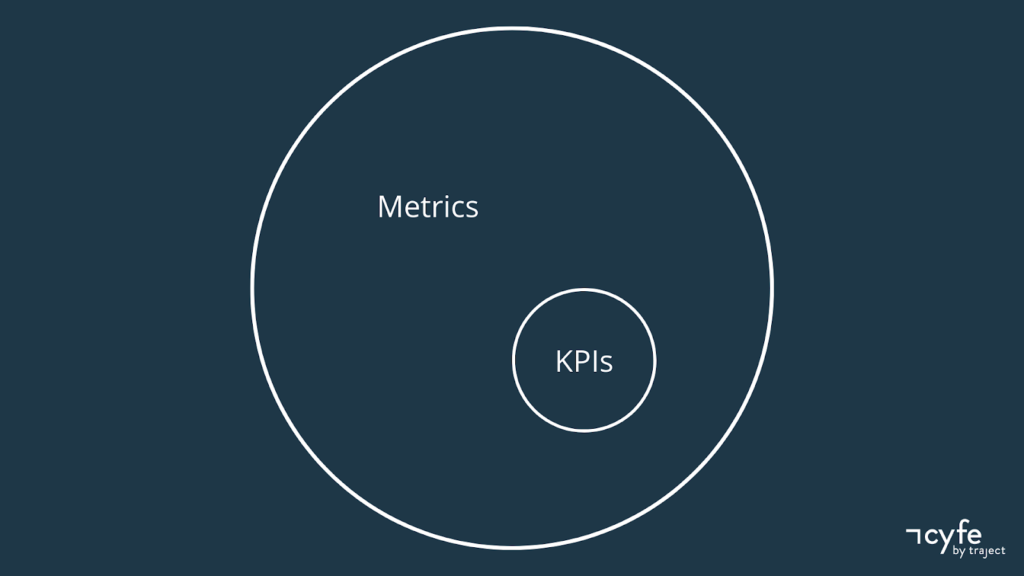
Within a specific KPI, you can have multiple relevant metrics that impact your goal. Let’s say, you want to increase your new trial signups by 10% in the next three months. The amount of traffic visiting your website and the conversion rate can both impact that objective.
How Do You Pick KPIs?
With so much data readily available, choosing the right KPIs can be challenging.
Selecting KPIs starts with defining a specific outcome. For example, let’s say a sales manager’s goal is to increase revenue by 20% over the next year. Sales performance metrics to track would include average deal size, sales pipeline coverage, and win rate.
When defining KPIs, consider these questions:
- What is your desired outcome?
- What effect will this outcome have?
- How can you measure progress?
- How often do you need to review progress towards that goal?
- How will anyone responsible for that KPI influence the desired outcome?
- Who is responsible for a specific outcome?
Think about also the dynamics of different KPIs and how you can leverage KPIs toward goals at different levels. Many businesses use KPIs to measure the success of:
- The overall company
- Specific departments
- Vital projects
- Individual’s performance
High KPIs are key performance indicators that target company-wide goals. Low-level KPIs focus on specific department’s strategies or individual’s day-to-day work.
The number of KPIs in place depends on the number of strategic objectives a company has. However, a clear plan has at least 5-7 high key performance indicators. Teams and individuals should have 3-10 low-level KPIs in place depending on the number of active objectives.
Pro-tip: Be aware of metrics that anyone can game. Let’s say your customer service team wants to track how efficient reps are at resolving issues. If you track average handle time for calls, a rep could easily manipulate their average by hanging up during calls. A more suitable KPI might be first contact resolution (FCR).
Share the reasons behind the KPIs you selected to track in the planning stages with stakeholders whether it’s your direct reports or company leaders.
Be prepared to make the case for why you left out any specific metrics. Keep an open mind to any additional metrics they advocate to be KPIs. Among other reasons, they may have more direct experience on all the factors that can influence your goal.
5 High-Level KPI Examples
Your company might have organization-wide KPIs including:
- Revenue
- # of New Customers
- Churn Rate
- Lifetime Value (LTV)
- Monthly Recurring Revenue
As you know, no single person solely impacts these KPIs at a company. They require collaboration and teamwork.
Here are common KPI examples for different departments…
Sales KPIs
Sales managers or VPs may have sales KPIs in place including:
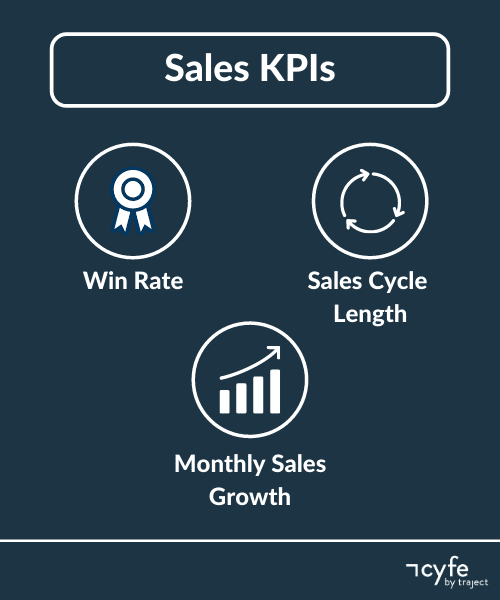
Win rate – the percentage of converted leads
Sales cycle length – the average amount of time between first contact and sales reps closing a lead
Monthly Sales Growth – the increase or decrease in sales from the previous month
Additional Helpful Resources for Establishing Marketing KPIs:
Customer Success KPIs
Beyond churn rate and LTV, customer success might identify as KPIs:
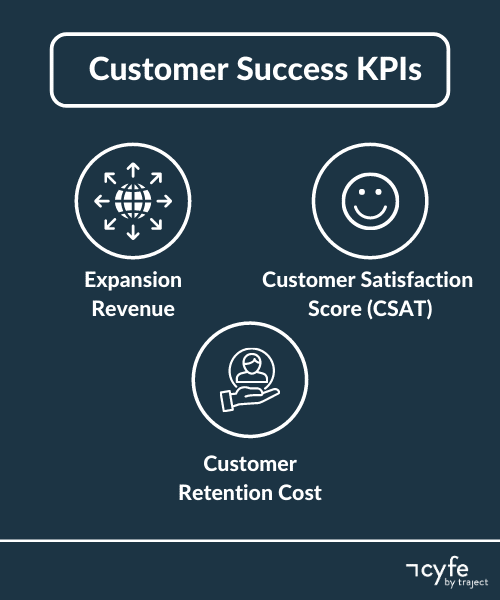
Expansion Revenue – the amount of new money coming from existing customers
Customer Satisfaction Score (CSAT) – the measurement of a customer’s satisfaction with a business, purchase, or interaction gathered via a survey
Customer Retention Cost – the total cost of a customer success program compared to the total number of active customers
Marketing KPIs
Whether you’re an in-house marketer at a venture-backed company or tracking marketing KPIs for small business owners, key metrics you can monitor include:
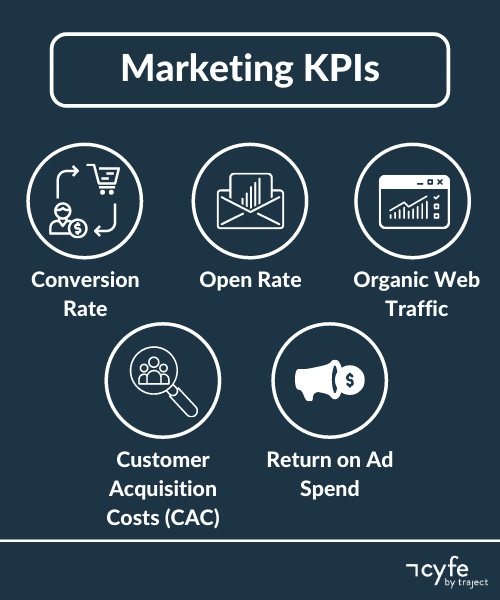
Conversion Rate – the percentage of users who complete a desired action
Organic Web Traffic – the amount of traffic a website generates through social media, SEO, and other channels
Customer Acquisition Costs (CAC) – the amount of money spent on getting new customers
Open Rate – the percentage of people who opened a given email
Return on Ad Spend – the amount of revenue a company earns for each dollar spent on advertising
Additional Helpful Resources for Establishing Marketing KPIs:
Human Resources KPIs
HR teams can monitor KPIs such as:
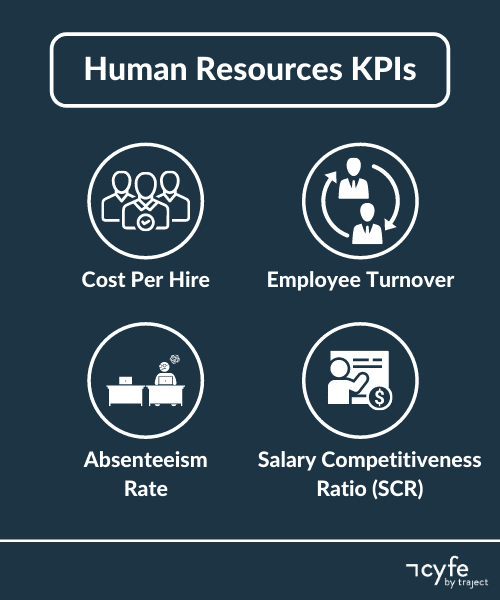
Cost Per Hire – the average amount of money spent on making a hire
Employee Turnover – the number of employees who leave a company during a specified period (often the period is based on one year)
Absenteeism Rate – the ratio of absences to workdays in a month, quarter, or year
Salary Competitiveness Ratio (SCR) – a measure of how competitive the current salary is that a company offers compared to a competitor or the overall market
How Do You Measure KPIs?
Specific tools can help you measure different KPIs including:
- Google Analytics for website traffic
- Salesforce for sales metrics
- Mailchimp for email KPIs
How Do You Monitor KPIs?
After you identify the KPIs you want to track, you’ll need a way to see in seconds how you or your team is performing.
Downloading reports from the previously mentioned platforms is an option. However, the built-in reporting requires more legwork customizing the reports to your business goals. Need to convert a report into a presentation? That can also consume your time.
Dashboards give you the ability to see and share results in real-time.
By connecting your data into pre-built dashboard templates, you can begin monitoring and sharing your KPIs in less than five minutes.
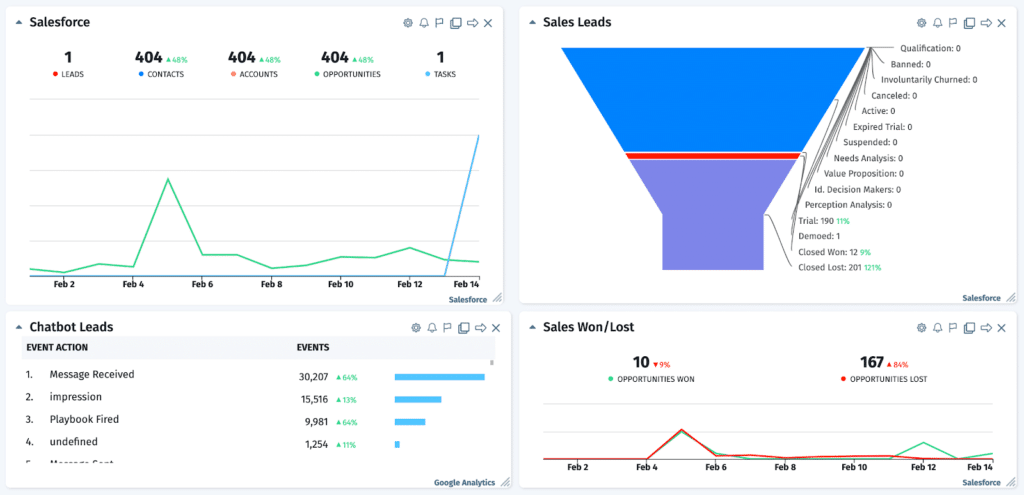
You can embed this highly visual view of your KPIs into a website, internal page, or anywhere else that accepts <iframe> tags.
If you’re wondering how often to check on reports, that will depend on your goals and the specific KPI. That said, here are a few general guidelines to consider:
- For low-level KPIs tracking individual performance, a manager at a minimum should be reviewing once a week for their direct report’s check-in.
- High priority KPIs you’ll want to review more often.
- Some KPIs, such as Monthly Recurring Revenue or Annual Recurring Revenue, measure a specific period so it will be clear how frequently you need to check them.
You can also get automatic notifications when there’s a major change in your KPIs through Cyfe. Set up rule-based alerts to receive notifications via email or SMS message.
How to Communicate KPIs to Your Team
Your team doesn’t want to feel like KPIs are a micromanagement tool. Communicating KPIs is all about positioning.
Your team members likely want to:
- Learn and improve
- See results from the time they invest
- Know the work they’re doing matters
Introduce key performance indicators to your team as an opportunity to grow. They’ll have the ability to objectively see when they’re off track and course-correct themselves.
One-on-one meetings can shift to the big picture when you empower your team to self-correct in real-time. Then you can focus on continuous improvement, new goals, and their personal development.
Instead of anyone feeling like they’re micromanaged, you can show how your strategy aligns with what the team does every day. Then any manager can have a more engaged team.
How Do You Track and Evaluate KPIs?
Beyond tracking KPIs in dashboards, you also need a framework for managing and communicating goals.
One of the most popular is the Objectives and Key Results (OKR) framework. OKRs were popularized in the tech space by Google and consist of:
- An Objective
- Up to 5 Key Results that measure the progress of that objective
- Initiatives illustrating the work necessary to reach the desired results
Example Objective
✅ Grow business to one million annual revenue
Example Key Results
✅ Increase monthly recurring revenue by 25%
✅ Decrease customer acquisition costs to $100 per lead
✅ Reduce churn rate by 10%
Example Initiatives
✅ Cross-sell by department with existing customers
✅ Shift budget to ad channels with the highest return on spend
What are KPI SMART Goals?
Consider also implementing SMART plans to manage your or your team’s goals. In case you need to break this down for others, SMART Goals are a framework many organizations use to set goals.
SMART stands for:
- Specific
- Measurable
- Attainable
- Relevant
- Time-bound
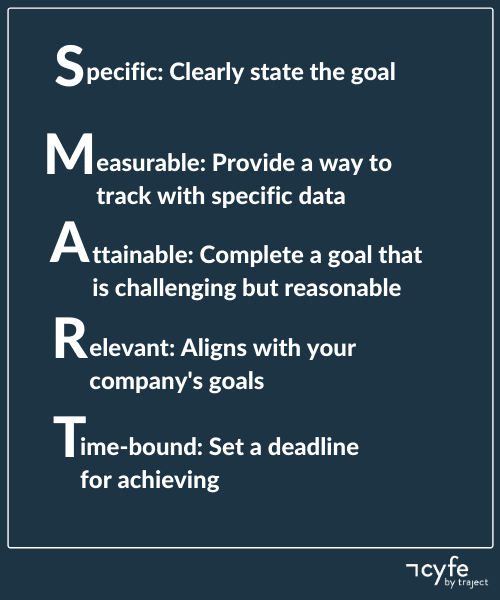
Many SMART plans contain KPIs since key performance indicators satisfy the specific and measurable requirements of SMART goals.
Let’s say you’re a customer service manager. You see a rep on your team only touches five support tickets a day. During a one-on-one meeting, you outline a SMART goal to increase the number of tickets that rep resolves per day.
Here’s what that SMART plan might look like:
- Specific – Increase the number of resolved tickets per day by 15% using bookmarks for resources and TextExpander to avoid typing out repetitive messages.
- Measurable – You and the rep will monitor their Average Resolution Time, the total time taken to resolve the support ticket once viewed.
- Attainable – Other team members have decreased their average resolution time with TextExpander and other tools.
- Relevant – Completing more support tickets in a day reinforces a department goal to respond to each customer within 24 hours.
- Time-bound – The goal needs to be completed within the next 30 days.
Establish SMART plans during one-on-one or team-wide meetings. With historical data, you should also be able to see whether a goal is attainable and realistic in a specific timeframe.
Summing It Up
Bottom line: KPIs help you stay on track towards business goals. SMART or OKRs plans help keep everyone aligned and on target.
By taking a few minutes to set up dashboards, you can quickly review and share KPIs. Then anyone on your team can see the direct results of their time at work.



